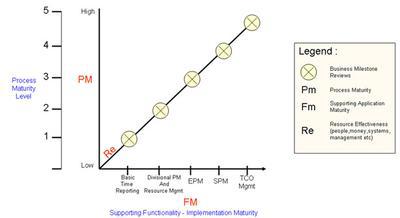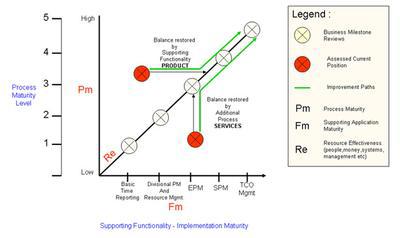When considering portfolio management in a project environment, software functions will include time recording through project portfolio management to enterprise portfolio management. Greg Jarvis explains how business can minimise the risk of implementing any new project management system.
Often organisations work on the basis that they must get the 'complete' process in place before thinking about any form of automation. This can lead to delays arising from the prolonged timescales involved in attempting to get an entire organisation to agree on common practices. This is particularly the case when operating in globally diverse organisations where differing local practices and cultures have to be taken into account.
At the other end of the spectrum organisations will dive straight in and implement a software application, assuming that this will instil some degree of automation to common processes and best practices. Both approaches come with the risk of failure.
The approach suggested in this article provides a generic framework that will both minimise the risk and help lead to a successful system implementation comprising both process and supporting software applications.
Balancing process and supporting systems
The first stage is to seek a balance between process maturity and supporting functionality. This is illustrated in Figure 1.

The Y-axis represents an organisational maturity scale; this could be either an industry standard such as CMM or an internal aspirational one. For the purposes of this discussion CMM has been used. In this framework the maturity levels represent:
- Initial: The software process is characterised as ad hoc, and occasionally even chaotic. Few processes are defined, and success depends on individual effort and heroics.
- Repeatable: Basic project management processes are established to track cost, schedule, and improve functionality. The necessary process discipline is in place to repeat earlier successes on projects with similar applications.
- Defined: The software process for both management and engineering activities is documented, standardised and integrated into a standard software process for the organisation. All projects use an approved, tailored version of the organisation's standard software process for developing and maintaining software.
- Managed: Detailed measures of the software process and product quality are collected. Both the software process and products are quantitatively understood and controlled.
- Optimising: Continuous process improvement is enabled by quantitative feedback from the process and from piloting innovative ideas and technologies.
The X-axis identifies the software supported functional areas. This example starts with time reporting and progresses to a total cost of ownership, and potentially beyond:
- Basic time reporting: Staff report how they are spending time and consolidated reports are produced.
- Divisional project and resource management: Projects are managed and resources are managed at 'local' level i.e. at divisional or departmental level but not corporately.
- Enterprise project management (EPM): Projects and resources are managed corporately and within a framework of corporate strategies.
- Service portfolio management (SPM): Brings resources used in supporting ongoing operations into the resource management arena.
- Total cost of ownership management (TCO): Consolidates resource costs from all sources represented above.
The sequence of the functions reflects the fact that an increasing level of process maturity is required to support each function. The terminology used will reflect an organisation's own functional area descriptions to facilitate common understanding and communication.
The diagonal path shows where the maturity level and supporting functionality are in alignment i.e. the level of process maturity achieved and the level of maturity supporting a function are equal. This can be called the line of balance. It is along this path that the resources (people, money, systems etc) required to implement the function will be operating most effectively.
An organisation's ability to maintain this balance whilst moving towards the end goal will be a reflection of the success of its cultural adoption capabilities. Any movement along or towards the line will engender change that must be communicated and managed.
Along the path business milestone reviews will take place where a check is made that the objectives of each stage have been met, that processes are in place to monitor ongoing benefit delivery and that plans are in place to move forward to the next milestone.
Once this basic framework is established an organisation can assess its current position within it, and if it becomes apparent that an imbalance exists i.e. they are not on the line of balance, they are faced with two possible routes to re-establish the balance and improve resource effectiveness. Figure 2 illustrates each of these cases.

An organisation that is very mature in terms of process but with little software application support will probably experience long reporting cycles, inconsistent and inaccurate data and an inability to cope with changes in a timely manner. It will probably be overwhelmed by data volumes. Such an organisation should consider introducing the appropriate level of software application support to address all the previously mentioned areas. This will establish a balance and lead to an improved decision support environment, making already mature processes more effective.
On the other hand an organisation that has low process maturity but has implemented - or, as in many cases, tried and failed to implement - supporting software applications that are at a higher level of functional sophistication than their processes will support, will probably have experienced inconsistent user adoption, duplication of data and redundant reporting. Such an organisation must consider redressing the balance by taking a step back and improving the way they utilise the software applications by improving their level of process maturity.
Many organisations are caught in a Catch 22 situation where on the one hand service-oriented companies will push process as being the key to success, whilst application-oriented companies will believe that software is the answer. The truth lies somewhere in between and provided a planned, measured approach is adopted the most effective balance can be achieved.
A balanced roadmap
In our example so far a single line of balance has been considered. However, in reality the balance between maturity and supporting functionality must be maintained across a number of operational streams that support a system implementation. Typically we might see up to six streams.
- technology and infrastructure;
- process definition;
- training;
- application development/ implementation and integration;
- metrics and improvement;
- cultural adoption.
Optimal resource effectiveness will be achieved where the resources applied to each stream are sufficient to deliver the required level of process maturity and the supporting functionality necessary to meet each milestone as an implementation progresses.
On achievement of each milestone a review can be undertaken to determine, for each operational stream, the resource required to meet the next milestone. This approach will ensure that progress for each stream is synchronised and that resource is not expended unnecessarily on moving any single stream further along the implementation path than is necessary.

Conclusion
The theory is relatively straightforward, as for the most part it is common sense. However, the realities of executing such an all-embracing implementation are somewhat different. Organisations change, mergers occur, technology moves on, key stakeholders leave and so on. In a competitive world, to stand still is to loose ground; progress is essential. The passage of time is never an ally and the longer things take, the higher the risk of failure. A well-defined strategy, comprising clear steps with measurable objectives, aligned to a strategic direction will deliver the benefits required to keep an organisation competitive and world-class.
Greg Jarvis is general manager at Planview northern region.












